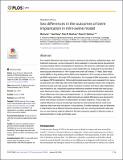| dc.contributor.author | Wong, Gee | |
| dc.contributor.author | Markham, Peter M. | |
| dc.contributor.author | Kunio, Mie | |
| dc.contributor.author | Edelman, Elazer R | |
| dc.date.accessioned | 2018-04-24T18:22:41Z | |
| dc.date.available | 2018-04-24T18:22:41Z | |
| dc.date.issued | 2018-01 | |
| dc.date.submitted | 2017-07 | |
| dc.identifier.issn | 1932-6203 | |
| dc.identifier.uri | http://hdl.handle.net/1721.1/114942 | |
| dc.description.abstract | This is an open access article distributed under the terms of the Creative Commons Attribution License, which permits unrestricted use, distribution, and reproduction in any medium, provided the original author and source are credited. Sex-related differences have been noted in cardiovascular anatomy, pathophysiology, and treatment responses, yet we continued to drive evaluation of vascular device development in animal models without consideration of animal sex. We aimed to understand sex-related differences in the vascular responses to stent implantation by analyzing the pooled data of endovascular interventions in 164 Yucatan mini-swine (87 female, 77 male). Bare metal stents (BMS) or drug-eluting stents (DES) were implanted in 212 coronary arteries (63 single BMS implantation, 68 single DES implantation, 33 overlapped BMS implantation, and 48 overlapped DES implantation). Histomorphological parameters were evaluated from vascular specimens at 3–365 days after stent implantation and evaluated values were compared between female and male groups. While neointima formation at all times after implantation was invariant to sex, statistically significant differences between female and male groups were observed in injury, inflammation, adventitial fibrosis, and neointimal fibrin deposition. These differences were observed independently, i.e., for different procedure types and at different follow-up timings. Only subtle temporal sex-related differences were observed in extent and timing of resolution of inflammation and fibrin clearance. These subtle sex-related differences may be increasingly important as interventional devices meld novel materials that Erode and innovations in drug delivery. Erodible materials may act differently if inflammation has a different temporal sequence with sex, and drug distribution after balloon or stent delivery might be different if the fibrin clearance speaks to different modes of pharmacokinetics in male and female swine. | en_US |
| dc.description.sponsorship | National Institutes of Health (U.S.) (Grant R01 GM49039) | en_US |
| dc.publisher | Public Library of Science | en_US |
| dc.relation.isversionof | http://dx.doi.org/10.1371/journal.pone.0192004 | en_US |
| dc.rights | Creative Commons Attribution 4.0 International License | en_US |
| dc.rights.uri | https://creativecommons.org/licenses/by/4.0/ | en_US |
| dc.source | PLoS | en_US |
| dc.title | Sex differences in the outcomes of stent implantation in mini-swine model | en_US |
| dc.type | Article | en_US |
| dc.identifier.citation | Kunio, Mie et al. “Sex Differences in the Outcomes of Stent Implantation in Mini-Swine Model.” Edited by Mohammad R. K. Mofrad. PLOS ONE 13, 1 (January 2018): e0192004 © 2018 Kunio et al | en_US |
| dc.contributor.department | Institute for Medical Engineering and Science | en_US |
| dc.contributor.mitauthor | Kunio, Mie | |
| dc.contributor.mitauthor | Edelman, Elazer R | |
| dc.relation.journal | PLOS ONE | en_US |
| dc.eprint.version | Final published version | en_US |
| dc.type.uri | http://purl.org/eprint/type/JournalArticle | en_US |
| eprint.status | http://purl.org/eprint/status/PeerReviewed | en_US |
| dc.date.updated | 2018-04-20T18:18:31Z | |
| dspace.orderedauthors | Kunio, Mie; Wong, Gee; Markham, Peter M.; Edelman, Elazer R. | en_US |
| dspace.embargo.terms | N | en_US |
| dc.identifier.orcid | https://orcid.org/0000-0003-0525-4723 | |
| dc.identifier.orcid | https://orcid.org/0000-0002-7832-7156 | |
| mit.license | PUBLISHER_CC | en_US |
